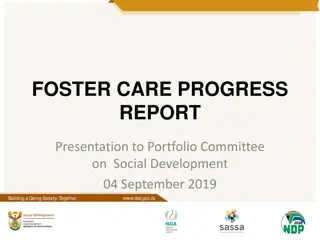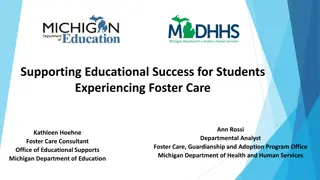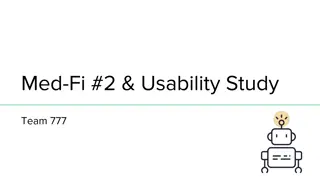Foster Care Redesign in Texas: Goals, Legislation, and Principles
The House Human Services Committee Interim Charge focuses on monitoring the implementation of Foster Care Redesign in Texas, evaluating its impact on the child welfare system, discussing the adoption process, and ensuring child safety. The goals of the redesign include promoting positive outcomes for children and families, improving care quality, and reducing the number of placements. Legislation guides the redesign process, emphasizing improved outcomes for children. Foundational principles ensure that children are safe, connected to their communities, involved in decisions, and respect their culture.
Download Presentation

Please find below an Image/Link to download the presentation.
The content on the website is provided AS IS for your information and personal use only. It may not be sold, licensed, or shared on other websites without obtaining consent from the author. Download presentation by click this link. If you encounter any issues during the download, it is possible that the publisher has removed the file from their server.
E N D
Presentation Transcript
House Human Services Committee Interim Charge: Foster Care Redesign Judge John Specia, DFPS Commissioner April 15, 2014 1
Interim Charge Monitor the implementation of Foster Care Redesign and evaluate its impact on the child welfare system in areas of the state where redesign is underway, including transition from the legacy system, foster family retention and recruitment, placement stability, permanency, and child safety Discuss the Texas adoption process Child safety data and safety efforts 2
Goals of Foster Care Redesign Through Redesign, DFPS seeks to: Promote positive outcomes for children, youth, and families. Improve the overall process and quality of care. Buy services where they are needed and reward good performance. Utilize and build on the strengths of communities. Goals of Redesign: Keep children and youth closer to home and connected to their communities and siblings. Improve the quality of care and outcomes for children and youth. Reduce the number of times children move in foster care. 3
Legislation Guiding Foster Care Redesign SB 218 by Nelson - 82nd Requires DFPS to implement a redesign of the foster care system in accordance with the PPP s Foster Care Redesign report. HB1, Rider 25 - 82nd Requires DFPS to submit a report that includes expenditures for foster care and progress toward achievement of improved outcomes for children, youth and families based on the quality indicators. SB 1, Rider 29 - 83rd Requires DFPS report selected performance measures that will allow for comparative analysis between the legacy foster care and redesigned foster care systems; and The most recent data for the selected comparative performance measures, an analysis of the data that identifies trends and impact, identification and analysis of factors negatively impacting any outcomes, recommendations, and other information necessary to determine the status of Foster Care Redesign. 4
Foundational Principles of Foster Care Redesign All children and youth are: Safe from abuse and neglect in their placement Placed with their siblings in their home communities Appropriately served in the least restrictive environment that supports minimal moves Provided opportunities to participate in decisions that impact their lives Able to maintain important connections to family and others Services respect the child s culture Youth are provided opportunities, experiences and activities similar to those experienced by their non-foster care peers so they can be fully prepared for successful adulthood. 5
How Does Foster Care Redesign Improve How We Do Business? Changes the way DFPS procures for foster care and other purchased services From an open enrollment to a competitive procurement process Changes the way DFPS contracts for foster care and other purchased services Move to performance-based contracts Changes the way DFPS pays for foster care and other purchased services From multiple rates to a single blended foster care rate and allocation Implemented through a staged approach based on Single Source Continuum Contract performance 6
Foster Care Redesign Model Development Stakeholder Input Public Private Partnership (PPP) Serves as the Guiding Body for Redesign Members represent key stakeholder groups Tasked with making recommendations about the foster care system to the DFPS Commissioner A broad base of stakeholders Participated in regional and statewide forums Gathered input from state foster youth and alumni 7
Foster Care Redesign Locations 8
Regions 2 & 9 Providence Service Corporation Initial Non-Metropolitan Catchment Area First Single Source Continuum Contract (SSCC) awarded to Providence Service Corporation of Texas (PSC) in December 2012 under Foster Care Redesign. Catchment area includes 60 counties with population hubs located in Wichita Falls, Abilene, San Angelo and Midland/Odessa Six-month start-up period: February 1st-August 25th 2013 First Child referred to PSC: August 26th 2013 9
Regions 2&9 Providence Service Corporation Performance Metric Indicators 2 Year Baseline Target for SSCC Performance Actual Performance 8/26/13-11/30/13 Actual Performance 12/1/13-2/28/14 Safety % who do not experience abuse, neglect, or exploitation while placed with SSCC 99.7% 100% 100% 100% Stability % who did not have a placement change during the previous 12 months, counting only changes that occur while in the SSCC s care 64.1% 66.1% 94.1% 87.9% Maintaining Connections % of cases where all siblings are placed together 63.6% 64.6% 76.3% 60.3% Maintaining Connections % who have at least one monthly contact with a significant other or family member who is not a parent or sibling 78.7% 80.7% 81.9% 82.8% Youth fully prepared for adulthood % of 17 year olds who have completed PAL Life Skills Training 75.3% 80.0% 66.7% 88.2% Least Restrictive Placement % placed in foster family home 68.1% 69.1% 57.9% 66.6% 10 Note: 2 year baseline is DFPS' performance
Outcome Evaluation Process DFPS is currently assessing permanency outcomes, placement stability, and re-entry rates with the assistance of the University of Chicago s Chapin Hall The University of Colorado s Kempe Center for the Prevention and Treatment of Child Abuse and Neglect is providing assistance with the work to assess the percentage of placements made within 50 miles of the child s home of removal. Performance data will be reported and published on website every 6 months. A Continuous Quality Improvement process will be used to help ensure every opportunity to improve outcomes for children and youth in the care of the SSCC. 11
What Have We Learned During The Initial Implementation? Automation: Increase testing prior to the start-up phase and allow SSCC early access to automation system Require SSCCs to have trained and dedicated resources to manage information technology (IT) issues Communication: Partner with SSCCs in the development of a meaningful communication plan and develop and deliver joint presentations to key stakeholders Ensure regular communication with PPP (quarterly meetings) Structure and Organization: Ensure that the SSCC staff and the DFPS staff responsible for developing catchment plans and protocols are well informed decision-makers Establish very clear communications channels, including monthly face-to-face meetings, within and between DFPS and the SSCC 12
Region 3b ACH Child and Family Services Initial Metropolitan Catchment Area Second SSCC contract awarded to ACH Child and Family Services (ACH) of Fort Worth in December 2013. Six-month start-up period: Jan. 1st - June 30th 2014 Begin transition of children from legacy system to ACH Redesign model July 1, 2014 New and subsequent placement referrals will begin Sept. 1, 2014 13
Region 3b ACH Child and Family Services The ACH model includes: Increasing the capacity of existing providers and identify more community-based supports and services. Conducting a comprehensive assessment of community needs and an analysis to find gaps between the need for services and their availability. Ensuring comprehensive safety and risk assessments to evaluate family strengths and needs. Utilizing a trauma-informed and trauma-based care service approach. Use of a comprehensive continuous quality improvement (CQI) process to assess, inform, and guide how services are provided and the system improved. 14
Next Steps Foster Care Redesign is a dynamic process where information and data are gathered, shared with stakeholders and used to inform changes as the state continues its cascading roll-out. DFPS will be posting performance data, and making it available to the PPP as they make their recommendations. DFPS anticipates announcing the next catchment in May 2014 and releasing the next RFP in the late summer 2014. 15
How Can You Adopt a Child in Texas? There are two options for adoption a family can utilize: Private or independent adoptions and International adoptions are regulated by DFPS and involve children that are not in DFPS conservatorship. Child Protective Services adoptions are regulated by DFPS. CPS is responsible for finding adoptive placements for children that are in DFPS conservatorship. 16
Texas Ranks 2nd in the Nation on Getting Children Adopted 80% Federal Fiscal Year 2012 76.3% 70% 74.3% 60% 55.6% 50% 52.2% 47.3% 40% 40.6% 30% 20% 10% 0% National Alaska (#1)Texas (#2) New York California (#31) Florida (#41) (#21) *Of all exits not including reunification, the percent of children who exited to adoption. Data Source: Administration of Children & Families, Children s Bureau Child Welfare Outcomes Report 17
Number of DFPS Children Adopted Up by 69% 5,500 5,364 5,000 4,500 4,000 3,500 3,173 3,000 FY05 2005 2006 2007 2008 2009 2010 2011 2012 FY06 FY07 FY08 FY09 FY10 FY11 FY12 FY13 2013 Source: DFPS Data Book 18
We Still Have Work To Do Number of Children with Terminated Parental Rights and Not in Their Adoptive Placement as of February 28th of each year 4,500 4,000 Number of Children 3,832 3,500 3,752 3,626 3,437 3,000 3,177 2,500 2,000 1,500 1,000 500 0 2010 2011 2012 2013 2014 Source: DFPS Data Warehouse Reports 19
How Does an Adoptive Family Move Through the DFPS Adoption Process? Family's agency submits home study to be considered for child Family is approved for adoption Family selected Family becomes aware of child Adoption Assistance process initiated Meeting held within 30 days of Family being selected Pre-placement visits with child and family occur Family reviews background information about the child Child's transition and family's adjustment monitored for 6 months Child placed in adoptive home Adoption Consummation 20
Supporting Adoptive Families Adoption Assistance Non-Recurring Adoption Expenses College Education Assistance Post-Adoption Services 21
Recruiting Adoptive Families The Texas Adoption Resource Exchange (TARE) is a referral and photo-listing service operated by CPS that provides information on children waiting for adoption. Photos, profiles, videos, and inquiry forms for children awaiting adoption are available on the internet at: www.adoptchildren.org 22
Jonathan and Vanessa TARE ID #24286 Ages: 17 and 16 Region: 6 We enjoy playing and watching television together. We have similar interests, but also have additional individual interests. www.adoptchildren.org
Michelle TARE ID #33187 Age: 16 Region: 3 I love to watch cartoons! Her worker says, Michelle is funny and has a very active imagination. She loves to play outside and explore things! www.adoptchildren.org
DeMichael TARE ID #41090 Age: 16 Region: 3 I am a happy boy with a sweet smile who enjoys laughing and interacting with people. His caseworker says, DeMichael is such a sweetie. He requires total care and I hope to find a forever home for him. www.adoptchildren.org
Jason, Ivory, and Harriniqa TARE ID #25948 Ages: 17, 16, and 12 Region: 7 We're engaging, outgoing, and waiting for a family who can raise us together. Their worker says, This sibling group is outgoing and brave. They look out for each other and remain loyal to each other. www.adoptchildren.org
Franklin TARE ID #44795 Age: 11 Region: 1 Must love horses! His worker says, Franklin is active and enjoys the outdoors. He likes horses and would like to live out in the country like the cowboys." www.adoptchildren.org
Texas Faith Based Collaboration Model CPS has conservatorship; The church has stewardship; and Communities have ownership. ~ Bishop Aaron Blake ~ Greater Faith Community Church Brownwood, TX 28
The Faith Based Community Has Joined the Effort Faith-based organizations help with prevention, foster care and adoption, and youth transitioning to independent living Currently there have been 114 churches recruited to participate in the Faith Based Collaboration 107 churches attended informational meetings with the intent to develop and launch Faith Based Ministries in the future 16 churches have begun recruiting foster/adopt families 13 other Orphan Care Ministries have been launched 29
DFPS Child Data 7,159,172 Children Living in Texas for FY 2013 27,924 229,138 Total CPS Initial Intakes of Abuse/Neglect Children were in the state s conservatorship on August 31, 2013 160,240 Abuse/Neglect Investigations Completed by CPS 16,676 1,189 10,059 Children were in paid foster care 66,398 Confirmed Victims of Abuse/Neglect Children were in Other Settings Children were in Kinship Care 30
Child Fatalities in the General Population Abuse/Neglect Child Fatalities in Texas FY 2013 Total 156 (10 fatalities in DFPS conservatorship) Neglect fatalities include: Drowning Unsafe Sleep Medical Neglect Abuse fatalities include: Blunt Force Trauma Stabbing Suffocation Abuse 41% (64) Neglect 59% (92) 31
Child Safety Plan DFPS developed a child safety action plan that includes implementation of the recommendations in an internal audit and changes proposed in response to specific child fatality cases, identified trends, or as a recommendation from a child safety forum with providers and stakeholders. Areas addressed in the child safety plan include: o Child fatality review process o Kinship Care o Foster Care o DFPS training and casework practices o Regulation of contracted providers 32
A Happy Ending! The Cavazos family after adoption proceedings. Damien Cavazos, who turned 18 the very next day, put his arms around his new mom, Rebecca Cavazos, at far left of the photo. 33























